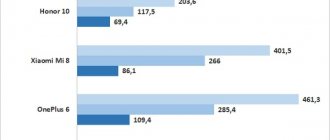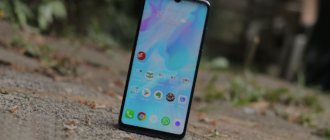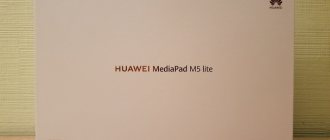Xiaomi is a popular Chinese manufacturer whose success began with the development MIUI shell
.
But he decided not to stop at the achieved results, and today the brand’s assortment includes a large selection of smartphones, external batteries, laptops, and any other equipment. To make it easier for you to make your choice, we have prepared a rating of Xiaomi smartphones 2020-2021, in which you will find the 12 best models to buy
this year.
The best budget Xiaomi smartphones
Redmi Note 9 4/128GB - you can never have too many cameras or when even a budget employee takes good photos
The people's favorite has been updated beyond recognition, receiving a number of improvements on all fronts. 84% of its front panel is dedicated to a 6.54-inch IPS display with FullHD+ resolution. In its upper left part you can see a miniature 13 MP selfie camera lens. The manufacturer has focused on balanced characteristics, striking design and photographic capabilities, which in this model exceed all expectations. The rear uses a combination of four sensors:
- 48 MP main;
- 8 MP ultra-wide-angle with a viewing angle of 119 degrees;
- 2 MP depth sensor;
- 2 MP lens for macro photography.
In combination with f/1.8 aperture, artificial intelligence and sophisticated algorithms, it is possible to achieve high quality photos during the day and minimize the amount of noise in night shots.
The popular smartphone became the first in the brand’s line to be powered by the new MediaTek Helio G85 processor with 8 cores and a frequency of up to 2 GHz. It is complemented by 4/128 GB of memory. Games run smoothly on medium-high graphics. Well, the main feature is a 5020 mAh battery. It lasts for 16.5 hours of video playback, and games at medium brightness consume 12% of the charge per hour. Support for 18 W fast charging is declared, but the package includes a 22.5 W unit. There is NFC and a 3.5 mm jack.
Pros:
- Spectacular appearance;
- Nice price tag;
- Operating time on one charge;
- Good cameras;
- NFC;
- 3.5 mm jack, separate slot for MicroSD and IR port for controlling home appliances.
Minuses:
- There is not enough brightness reserve, which is especially noticeable when exposed to direct sunlight;
- The video is not shot in 4K.
Xiaomi Redmi 9 4/64GB (NFC) - great autonomy for affordable money
The characteristics of the smartphone will be among the best in its price category. The large 6.53-inch IPS display with a resolution of 2400x1080 pixels immediately catches your eye. In its central part there is a drop-shaped cutout, where an 8 MP front camera was built in. She takes good selfies and participates in face unlocking.
Responsible for performance is the 8-core MediaTek Helio G80 chipset, which is combined with 4/64 GB of memory. You shouldn't expect much from it, but the games will run, and everything, just not on maximum graphics. A separate slot was left for the memory card, which means you don’t have to sacrifice one of the SIM cards to expand the capacity.
The model will delight you with its photographic capabilities. It implements a combination of four modules: 13 MP main, 8 MP ultra-wide-angle, 5 MP macro and 2 MP auxiliary sensor. Not far from them is the fingerprint scanner area. Like many other phones in the Redmi family, Redmi 9 has a high battery capacity of 5020 mAh. It lasts for a couple of days of use. Accelerated 18 Watt charging is supported. The kit includes a transparent silicone bumper.
Pros:
- Large display with good brightness and contrast;
- Photographic capabilities;
- Battery life;
- Latest version of Android;
- Radio and NFS;
- Slot for 2 SIM cards and a flash drive;
- Headset jack and IR port.
Minuses:
- The body is well assembled, but constructed of plastic;
- Performance is inferior to Snapdragon solutions.
Redmi Note 8T 4/64GB - a stylish Xiaomi smartphone with NFC and a gradient back
The Xiaomi Redmi Note 8T has little memory - only 4/64 GB, but the situation is easily solved by installing MicroSD, for which there is a separate slot. Its maximum capacity is 256 GB, which is more than enough. In addition to this, there is a moderately productive Qualcomm Snapdragon 665 processor with 8 cores and a frequency limit of 2 GHz. It is enough for games and for comfortable multitasking.
Rich and clear images are displayed on a 6.3-inch IPS display with FullHD+ resolution. But the frames around its perimeter are large by modern standards, which is why it occupies only 80% of the surface. At its top there is an elegant cutout for a good 13 MP selfie camera. The main one turned out no worse. It includes 48, 8, 2 and 2 megapixel modules with f/1.8 aperture. A special night mode combines four pixels into one, improving contrast and reducing digital noise.
The battery is not so large - 4000 mAh, but it is enough for 12 hours of video playback and 5 hours of gaming. It charges up to 50% in half an hour. An hour of video playback consumes only 7% of the charge. There is NFC and an infrared port, which can be used instead of the remote control for a TV, projector, air conditioner and other equipment. The matrix and glass back are covered with ultra-strong Corning Gorilla Glass 5 to prevent scratches.
Pros:
- Design;
- Splash-proof and Gorilla Glass 5;
- Large, rich and high-quality IPS display;
- A good camera that copes with its task adequately under any conditions;
- Autonomy and fast charging via Type-C port;
- NFC, infrared;
- Separate slot for MicroSD.
Minuses:
- No LED event indicator;
- Auto brightness does not work correctly.
Redmi Note 9S 4/64GB is one of the most popular models in the price category up to 15,000 rubles
The TOP of Xiaomi smartphones has been replenished with a new model, impressive with its characteristics. By choosing it, you get a decent level of gaming performance, which is facilitated by the 8-core Snapdragon 720G chipset with 8 cores and a frequency of up to 2.3 GHz. There are two memory modifications - 4/64 or 6/128 GB. Regardless of the version chosen, a microSD of the required size can be placed in a separate slot. This is enough for resource-intensive applications and demanding games. Music lovers will be pleased with the presence of a 3.5 mm audio jack.
| On the subject: The best Redmi smartphones |
85% of the area is occupied by a 6.67-inch display, which displays a detailed image with a resolution of 2400x1080 pixels. The drop-shaped cutout for the 16 MP front camera is placed exactly in the center, and four modules of 48, 8, 2 and 2 MP are installed on the rear. They decided to abandon the classic location of the fingerprint scanner and install it on the side. The solution is convenient; the finger falls on it automatically when gripping the phone normally. The downside is the lack of an NFC chip. But there is an infrared port and a 5020 mAh battery with powerful 18 W charging.
Pros:
- High build quality;
- Spectacular design;
- Autonomy;
- Quality of photos taken during the day;
- Event sensor and IR port;
- Dedicated slot for MicroSD;
- Fast side fingerprint scanner;
- 3.5 mm audio jack;
- Rich and frameless display.
Minuses:
- Lack of NFC;
- Photo quality noticeably sags in low light;
- There is no stabilization when shooting in 4K.
⇡#Shooting in the interior with a standard viewing angle
This is a noticeably more difficult scene - accurate work with white balance, high-quality detail with good noise reduction and not only a wide dynamic range, but also reliable operation of the optics with numerous sources of artificial light are important here.
| Top row from left to right: Apple iPhone Xs Max, Google Pixel 3 XL; bottom row from left to right: Huawei Mate 20 Pro, Samsung Galaxy S10+, Xiaomi Mi 9 | ||||
| Top row from left to right: Apple iPhone Xs Max, Google Pixel 3 XL; bottom row from left to right: Huawei Mate 20 Pro, Samsung Galaxy S10+, Xiaomi Mi 9 | ||||
In this scene, Huawei's penchant for warm tones works to this smartphone's advantage—colors look natural. The soapiness that we noticed when shooting the street landscape goes away somewhere - the details are clearly defined. Samsung again shows a tendency towards slight overexposure, but provided the dynamic range is good, this does not harm the picture. The colors are cooler than they should be. Xiaomi acts in a very similar way in this story – high-quality work. The iPhone, the colors of which look great on the display of the smartphone itself, on the screen of a calibrated monitor produces a picture that is already too cold, and the difference between the warm bottom and the cold top is pronounced. Pixel is also quite good, but loses to competitors in detail and dynamic range (HDR+ is not included in the work).
- Huawei Mate 20 Pro – 5 points;
- Samsung Galaxy S10+ – 4 points;
- Xiaomi Mi 9 – 3 points;
- Apple iPhone Xs Max – 2 points;
- Google Pixel 3 XL – 1 point.
The best Xiaomi phones in terms of price/quality ratio
Xiaomi Mi Note 10 Lite 6/128GB - AMOLED display with HDR10 and an impressive 5260 mAh battery
Xiaomi managed to create a unique smartphone that combines a lot of positive aspects. I would also like to praise the battery life, which is a merit of the 5260 mAh battery. Not only does it discharge slowly, but it also reaches 58% capacity in 30 minutes from the included 30 Watt unit. The performance is in perfect order, because the Snapdragon 730G chipset and 6/128 GB of memory are hidden inside.
[/banner_reklama-jandeksa
This is enough to satisfy your gaming ambitions. The best Xiaomi phones in terms of price/quality ratio amaze with their capabilities. So, the picture is displayed on a stunning AMOLED display with support for HDR 10, curved edges and a built-in fingerprint scanner. It occupies 88% of the area thanks to its frameless design and operates at a resolution of 2340x1080 pixels. In its central part there is a drop-shaped cutout for a 16 MP selfie camera. The main camera is built on four modules with a resolution of 64, 8, 5 and 2 megapixels. They do their job perfectly.
Pros:
- Stylish body made of metal and glass;
- AMOLED matrix with HDR10, occupying 88% of the area;
- Decent cameras;
- Bluetooth codecs for high-quality sound in wireless headphones;
- Phenomenal battery capacity with 30-watt charging;
- NFC, IR port and 3.5 mm audio connector;
- Performance for any task.
Minuses:
- The case is not modest in size;
- You cannot get additional capacity using a memory card.
Redmi Note 9 Pro 6/128GB is the best choice when you are looking for Xiaomi under 20,000 rubles
In the Redmi line, this is the top model, which attracts with its power, cameras and capacious battery that can easily withstand a couple of days of use. 85% of the front panel is allocated to a 6.67-inch IPS display, in the center of which there is a miniature drop-shaped cutout for a 16 MP front camera. It is also activated when unlocking by face. Alternatively, there is a fingerprint scanner integrated into the side of the power key. In practice, the solution is extremely convenient.
The best Xiaomi smartphone is built on an 8-core Snapdragon 720G chipset combined with 6 GB (LPDDR4x)/128 GB (UFS 2.1) memory. There is a slot for a memory card, and its maximum capacity is limited to 512 GB. A 64, 8, 5 and 2 megapixel quad camera will help you capture bright moments. There is NFC, an infrared port and a powerful 5020 mAh battery, which is recharged by a complete 30-watt unit. A 100% charge takes 1 hour 25 minutes.
Pros:
- Beautiful body covered with 5th generation tempered glass;
- Great screen;
- Powerful iron;
- There is both NFC and infrared;
- Convenient location of the fingerprint scanner;
- 30-Watt charging;
- Capacious battery, and therefore good autonomy;
- Photo quality;
- Dedicated slot for MicroSD up to 512 GB;
- Generous equipment.
Minuses:
- Inconvenient digital zoom control mechanism in the stock Camera application;
- Slippery and massive body.
⇡#Testing
We'll evaluate results based on different criteria in different tests, but the key factors will be sharpness and detail. In addition, the result is affected by the correct exposure setting and white balance. In each test, a smartphone can score 1, 2, 3, 4 or 5 points, depending on its place in the subjective report card (first place - 5 points, fifth place - 1 point). The device with the most points will be named the best.
The presence of a wide-angle module cannot be ignored in the final assessment simply because the user has additional opportunities when using it. To evaluate its performance, a separate test was conducted with three participants - the winner received 3 points, the smartphone that took second place received 2 points, and the third place received 1 point. Accordingly, each of them received additional points in the overall report card.
Since we are not conducting a user survey, the purity of the experiment is not important here - the arrangement of photographs is always the same, in alphabetical order.
The best Xiaomi flagship smartphones
Xiaomi Mi 10 8/256GB - a flagship with a 90 Hz AMOLED screen, plenty of memory, but only one SIM card slot
The review of Xiaomi smartphones moves on to the flagships, of which the company has a lot. Mi 10 turned out to be successful in all respects, but buyers may be put off by only one slot for a SIM card. Only in the Chinese version there are two of them. It is not clear what this is connected with, because previously all the brand’s gadgets had two slots, including a separate one for MicroSD.
The main asset of the new product is a Super AMOLED display with a refresh rate of 90 Hz and support for HDR10+, which gamers will appreciate. It occupies 90% of the area and is curved on the sides. A miniature 20 MP selfie camera is built into the upper left part. The heart of the phone is the top-end Snapdragon 865 chip and 8/128 GB of LPDDR 5 and UFS 3.0 memory, respectively.
At the back there is a quad camera with a leading 108 megapixel lens, which takes the quality of photo detail to a new level. It is complemented by a 13 MP ultra-wide-angle sensor, as well as 2 auxiliary modules of 2 MP each. There is Bluetooth 5.1, NFC and, most importantly, Wi-Fi 6 with data transfer speeds of up to 9.6 Gb/s. The hardware is powered by a 4780 mAh battery with fast both wired and wireless charging (30 W). Reverse charging is also supported, which allows you to place headphones and other gadgets on the phone to recharge them.
Pros:
- Stunning camera with a leading 108 MP lens;
- Durable battery;
- Support for advanced technologies - 5G and Wi-Fi 6;
- Infrared and NFC;
- Fast, wireless and reverse charging;
- 90Hz display with HDR10+;
- There is a lot of memory and it is fast;
- The screen accounts for 90% of the area.
Minuses:
- The only slot for a SIM card.
Xiaomi Redmi Note 10 Pro
The best Xiaomi for price and quality is included in the rating for its stunning Super AMOLED display with a refresh rate of 120 Hz. Due to this, the image in games becomes as smooth as possible, which is especially noticeable when displaying dynamic scenes. The remaining characteristics are also excellent - the screen stretches to 6.67 inches with a resolution of 2400x1080 pixels, which gives them a high density of 395 ppi. Thin frames help occupy 86% of the area, and modern tempered Gorilla Glass v5 is responsible for protection against scratches. At the top, the 16 MP front camera lens is barely visible.
By choosing the popular Xiaomi smartphone, you get a high level of performance, because “under the hood” there is an 8-core Snapdragon 732G chipset combined with 8/128 GB of memory. Moreover, the volume can be expanded by installing MicroSD in a separate tray. The top-end Xiaomi boasts NFC, an infrared port, a fingerprint scanner built into the power button, and waterproof housing according to the IP53 standard.
Loud stereo speakers complement the immersive gaming experience and will delight all music lovers. Moreover, you can play and listen to music for a long time, because the battery capacity reaches 5020 mAh. And it charges quickly - by 59% in the first 30 minutes. Note 10 Pro has an advanced camera with a leading 108 MP lens, 8 MP ultra-wide-angle, 2 MP macro and 2 MP Bokeh. DxOMark experts rated the new camera at 106 points.
Pros:
- Screen with a huge margin of brightness and a frequency of 120 Hz;
- The fingerprint scanner responds instantly at the touch of a finger;
- NFC works very quickly;
- Excellent sound in stereo format;
- Separate slot for memory card and audio jack;
- The battery lasts for a couple of days with active use;
- Fast 33 W charging;
- Good cameras with a leading 108 MP lens;
- Beautiful and waterproof case;
- 8/128 GB UFS 2.2 memory.
Minuses:
- The proximity sensor sometimes unlocks the phone during a call.
Xiaomi Poco F3
The top-end Xiaomi is equipped with an AMOLED screen with a refresh rate of 120 Hz and a gaming processor with liquid cooling to prevent overheating. The effect of immersion in the gameplay is complemented by high-quality stereo speakers and a pleasant vibration response that accompanies the events taking place in the game. So that you can enjoy the gaming process for a long time, there is a 4520 mAh battery with support for 33 W charging, which reaches 100% in 52 minutes.
Seamless Xiaomi supports HDR10+ content and responds to touches faster than competitors thanks to the touch response rate of 360 Hz. Combined with a frequency of 120 Hz and a large diagonal of 6.67 inches, we get huge potential for games. Moreover, the processor here is one of the best in the world - Snapdragon 870 5G with 8 cores and a frequency of 3.2 GHz. It is combined with Adreno 650 graphics, 6/128 GB of UFS 3.1 memory and liquid cooling. This is the most powerful Xiaomi smartphone, as confirmed by AnTuTu tests, where it scored 629,822 points.
The cameras are also impressive - the main 48 MP lens is complemented by an 8 MP wide-angle lens and an 8 MP lens for macro shots. Video is recorded in FHD 60 fps and in 4K, but only 30 fps. You will take selfies using the 20 megapixel front camera. There is NFS, IR port, aptX HD, OTG, 5G and Wi-Fi 6 codecs.
Pros:
- Very thin case - only 7.8 mm thick;
- Efficient liquid cooling;
- One of the most powerful smartphones today;
- Quick unlock by face or side scanner;
- Stereo sound;
- Supports Wi-Fi 6, 5g and NFS;
- Stunning AMOLED matrix with a frequency of 120 Hz and HDR10+ support;
- Works for a long time on a single charge and charges to 100% in 52 minutes;
- Rich scope of supply;
- Pleasant vibration response.
Minuses:
- You cannot insert a memory card;
- The screen turns on periodically during a call;
- no 4K 60 fps.
Xiaomi Mi 10 Pro 8/256GB is the company's most breakthrough smartphone for 2021 with 8K video recording
The best Xiaomi phone to date
— Xiaomi Mi 10 Pro, which loudly announces itself with its bright appearance and technological filling.
It received a 6.67-inch waterfall screen
, smoothly turning into the side edges.
It is made using AMOLED
with its characteristic high brightness and contrast.
Gamers will appreciate the 90Hz refresh rate
.
Support for HDR10+
is declared .
20 megapixel front camera and a fingerprint scanner
are integrated into the matrix .
The device is based on the flagship Snapdragon 865. Memory can be 8/256 or 12/512 GB
.
It is unlikely that you will be upset by the lack of a MicroSD slot
with such a volume.
Only one slot is allocated for a SIM card
. Two are only available in the version for the Chinese market.
Main 108, 20, 12, 8 megapixel cameras
provide a minimum amount of noise, high detail and natural color reproduction.
There is 10x hybrid and 50x digital zoom
.
Video is recorded up to 8K.
The 4500 mAh battery lasts for a couple of days.
There is both fast and wireless charging. Stereo speakers provide not only loud, but also surround sound that is pleasant to the ears. There is NFC, an infrared port, and out of the box the device runs Android
Q.
Pros:
- Some of the best cameras on the market;
- Supports 5G and advanced wireless communications;
- The most powerful chipset to date;
- Up to 12 GB of RAM and 512 GB of internal memory;
- Top camera with a main 108 MP sensor;
- 50x zoom;
- Android Q;
- NFS and IR port;
- Gorgeous AMOLED display with a refresh rate of 90 Hz and HDR10+;
- Stereo speakers;
- Impressive autonomy.
Minuses:
- Only one SIM card slot.
⇡#Street landscape
A simple, basic scene where the camera's primary focus is detail, wide dynamic range, and color quality.
| Top row from left to right: Apple iPhone Xs Max, Google Pixel 3 XL; bottom row from left to right: Huawei Mate 20 Pro, Samsung Galaxy S10+, Xiaomi Mi 9 | ||||
| Top row from left to right: Apple iPhone Xs Max, Google Pixel 3 XL; bottom row from left to right: Huawei Mate 20 Pro, Samsung Galaxy S10+, Xiaomi Mi 9 | ||||
Shooting with the main camera, without using wide-angle or zoom mode, default settings are set everywhere (Huawei can use its “real-time HDR”, and Pixel 3 XL – HDR+). Here everyone performs well - this is exactly the scene where even budget devices should produce a normal picture.
The iPhone image looks the most pleasant - the colors are a little cold, but it looks thoroughbred; the detail is excellent. Galaxy is a little yellow, the picture is noticeably lighter, less contrasty, but it suits the stage. Pixel doesn't use its proprietary processing to its fullest, and shadows are not detailed enough. We also note reddish colors. Huawei, despite its very high status, produces a slightly soapy picture with failed shadows and too warm colors. Xiaomi has natural colors, but otherwise there is nothing to brag about: the dynamic range is weak and the detail is not the utmost.
Apple iPhone Xs Max – 5 points; Samsung Galaxy S10+ – 4 points; Google Pixel 3 XL – 3 points; Huawei Mate 20 Pro – 2 points; Xiaomi Mi 9 – 1 point.
⇡#Macro
In this case, the Huawei Mate 20 Pro has a natural advantage - the “super macro” mode with the activation of a wide-angle camera with a minimum focusing distance of 2.5 cm. The rest of the test participants work with the main camera and approximately the same focusing distance. In this scene, the most important things are sharpness and color rendering quality.
| Top row from left to right: Apple iPhone Xs Max, Google Pixel 3 XL; bottom row from left to right: Huawei Mate 20 Pro, Samsung Galaxy S10+, Xiaomi Mi 9 | ||||
| Top row from left to right: Apple iPhone Xs Max, Google Pixel 3 XL; bottom row from left to right: Huawei Mate 20 Pro, Samsung Galaxy S10+, Xiaomi Mi 9 | ||||
Huawei wins this competition without a fight - simply due to the fact that with its help you can shoot almost real macro. And then it’s a pretty tight fight. Google Pixel produces slightly colder colors, but it outperforms other competitors (except Mate, of course) in terms of sharpness. The Apple iPhone could actually claim second place in this competition - slightly different color rendition (the Apple smartphone is more likely to be “green”), and if it is inferior in sharpness, it is minimal. But the Pixel is still a little better. Samsung also demonstrates good sharpness, but does not cope well with exposure - in its style, it raises the brightness above the required level, but here this does not suit the picture. Xiaomi also has a quite working macro, but in all respects it is slightly inferior to its competitors - both in sharpness and in color rendition.
- Huawei Mate 20 Pro – 5 points;
- Google Pixel 3 XL – 4 points;
- Apple iPhone Xs Max – 3 points;
- Samsung Galaxy S10+ – 2 points;
- Xiaomi Mi 9 – 1 point.
⇡#Close-up portrait
For close-up portraits, we shot at a normal angle with the Samsung, with dual digital zoom on the Pixel, dual optical zoom on the iPhone and Xiaomi, and triple optical zoom (basic for this smartphone) on the Huawei.
| Top row from left to right: Apple iPhone Xs Max, Google Pixel 3 XL; bottom row from left to right: Huawei Mate 20 Pro, Samsung Galaxy S10+, Xiaomi Mi 9 | ||||
| Top row from left to right: Apple iPhone Xs Max, Google Pixel 3 XL; bottom row from left to right: Huawei Mate 20 Pro, Samsung Galaxy S10+, Xiaomi Mi 9 | ||||
In terms of color rendition, the situation echoes what we saw when shooting full-length portraits, but there is a noticeable difference in detail. The Pixel feels surprisingly confident again - when using the minimum digital zoom, there are simply no visible losses in detail. Samsung, due to the need to use a wide-angle camera to take a close-up portrait, noticeably “stretches” the face, distorting its features - alas, this again automatically throws the Korean flagship into last place. Huawei is also quite bad - when shooting with a threefold zoom, even in good lighting, sharpness drops significantly, this is also the result of an outsider. iPhone and Xiaomi rather share second place - each has its own trump cards, but the soft picture of the “Chinese” is subjectively a little more attractive.
- Google Pixel 3 XL – 5 points;
- Xiaomi Mi 9 – 4 points;
- Apple iPhone Xs Max – 3 points;
- Huawei Mate 20 Pro – 2 points;
- Samsung Galaxy S10+ – 1 point.
⇡#Full-length portrait
Modern flagship smartphones for the most part allow you not only to take portraits with software blurring of the background, but to choose how to shoot it - close-up or full-length. Somewhere - simply moving from the model, somewhere - using optical zoom. We took two portraits: full-length and close-up - in daylight, and one - with the most convenient distance for each smartphone (which is the default when activating portrait mode) - in artificial light. First, let's look at how smartphone cameras worked in a full-length portrait.
| Top row from left to right: Apple iPhone Xs Max, Google Pixel 3 XL; bottom row from left to right: Huawei Mate 20 Pro, Samsung Galaxy S10+, Xiaomi Mi 9 | ||||
| Top row from left to right: Apple iPhone Xs Max, Google Pixel 3 XL; bottom row from left to right: Huawei Mate 20 Pro, Samsung Galaxy S10+, Xiaomi Mi 9 | ||||
This is the most natural situation for the Samsung Galaxy S10+ and Google Pixel 3 XL - in the first case, the “live focus” mode, which blurs the background, for some reason does not involve using the zoom, so to take a close-up portrait you need to get closer to the subject. In the second, there is no optical zoom on the smartphone at all, but there is a completely working digital zoom, as we found out above.
I must say that the Pixel lives up to expectations - in this mode it really shows itself best: good skin tone, very high-quality blur (the best among all), high contrast. All skin imperfections will be noticeable, but the picture looks most natural. Huawei Mate 20 Pro, on the contrary, is very “youthful”, smoothing the skin in portrait mode (even with the beautifier disabled) and slightly yellowing, but the portrait again looks natural. The iPhone, which is famous for its natural colors, did not demonstrate this here, pushing skin tones into the red area. Xiaomi produced an even smoother picture than Huawei. It also, as usual, lacked dynamic range (note the overexposure on the nose), but the colors are very good. Samsung, unfortunately, makes the skin very soapy in the “live focus” mode, and nothing can be done about this behavior. It kills its other advantages in this mode - high-quality bokeh and color rendition.
- Google Pixel 3 XL – 5 points;
- Huawei Mate 20 Pro – 4 points;
- Apple iPhone Xs Max – 3 points;
- Xiaomi Mi 9 – 2 points;
- Samsung Galaxy S10+ – 1 point.











